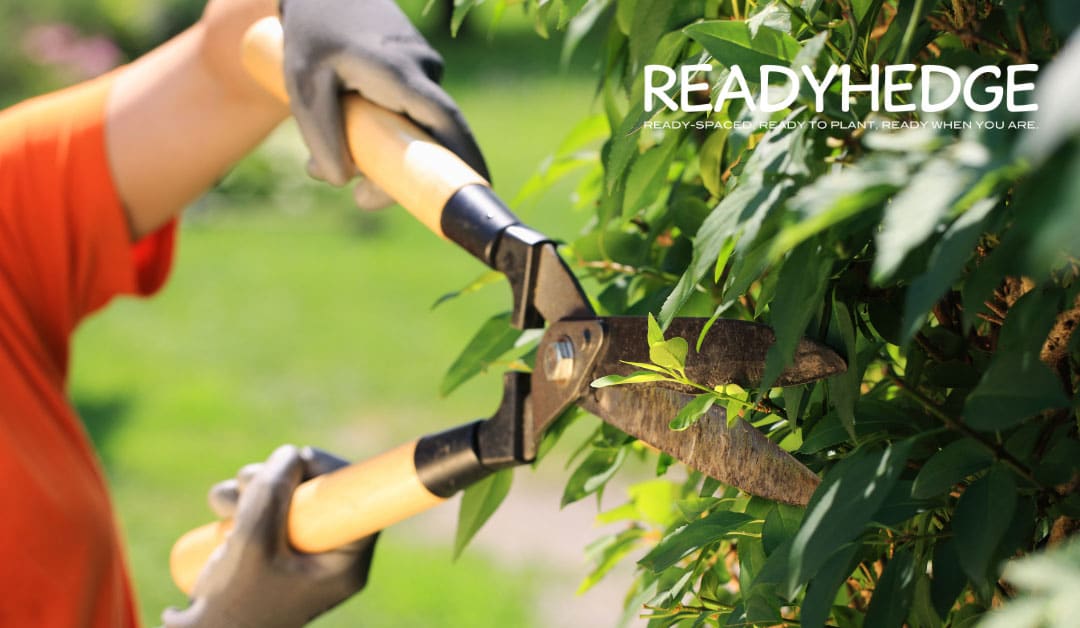After planting hedges, you should carry out formative pruning for the first couple of years. Typically, this should be done in the winter months or early spring.
Following this initial stage, you should then do annual maintenance trimming for informal hedging or bi-annual trimming for formal hedges. We would suggest doing this between spring and summer.
To help you trim your hedges correctly, we have put together our top 5 tips for trimming hedges.
Trimming Hedges based on Hedge Type
Hedges can vary greatly, which means so can the trimming method required to keep them in their best condition.
Informal and flowering hedges are easiest to look after as they require little to no trimming, however, they do have an untidier profile.
To maintain these types of hedges we would recommend cutting back leggy growth after the hedge has flowered to help maintain the shape of the hedge. You should also remove shoots with secateurs, not shears as this will avoid the problem of clipped leaves rotting.
For more formal hedges you need to trim these more closely to ensure you maintain a crisp outline. Read on to discover our tips for getting the straightest lines.
Low-growing box hedges can be cut with vertical sides, but if the hedge is over 30cm tall this should be tapered slightly towards the top. This is important because it will allow light to reach the bottom of the hedge, which we will talk more about.
Use Guides for Formal Hedges
Formal hedges can be the most difficult hedges to trim and maintain. They should be slightly tapered on both sides, ensuring the base is wider than the top.
They also need to be trimmed much more accurately than an informal hedge.
To ensure a straight line use a piece of string tied between two posts, this will help you cut the top of the hedge level. If you are using shears, keep these parallel to the line of the hedge. When using a hedge trimmer keep it parallel and use a wide sweeping action, working from the bottom of the hedge upwards.
For the top of the hedge, if you would like this shaped (for example into an arch), cut a template from a piece of carboard, place the template on the hedge and cut using the line of the template.
Keep Hedges Narrower at the Top
We briefly mentioned this earlier, but this tip is super important for maintaining a healthy hedge.
If left to grow a hedge will naturally become wider at the top as this is where it receives the most sunlight. However, this is a problem because it then shades the rest of the hedge, resulting in them producing less foliage.
To avoid this, you need to keep your hedges narrower at the top and wider at the bottom.
When cutting your hedges, start at the bottom and work towards the top.
Look out for Nesting Birds
Spring and early summer are particularly popular months for nesting birds (as well as other animals). Before trimming your hedges, it is important to check them for signs of nests.
Under the Wildlife & Countryside act 1981 it is an offence to damage or destroy the nest of any wild bird while it is in use or being built.
You may need to delay the job until the end of August if necessary. However, with conifer hedges, do not trim after August as this can encourage bare patches to form.
Use the Right Tools
Trimming hedges can require a variety of tools, each for a specific purpose. These include:
- Shears
- Pruning Poles
- Chainsaws
- Hedge Trimers
- Secateurs
Depending on your hedge type and size you may only require one or two of these, but if you have multiple hedge types it’s important, you’re choosing the right tools for the job.
Here’s what you should be using based on hedge type.
Secateurs
Shears
Hedge-trimmer
- conifer hedges
- established privet
- hawthorn
- large deciduous hedges
- mixed native hedges
TOP TIP
The tools you use for trimming hedges must be very sharp and ideally should be professionally sharpened. After use clean off plant resin to ensure a good cut the next time that it is used. Do this by scraping off the blades with a knife (being careful) and clean with soapy water. Leave to dry and then apply a small amount of WD40 to ensure that no rust forms and wipe any excess from the blade.
Hedge trimmers need regular sharpening to reduce stem damage and tearing on the leaves.
It’s also important to note that Box/Taxus/Lonicera may go white on the leaves 2 weeks after using a hedge trimmer due to excessive mechanical damage done while trimming.

